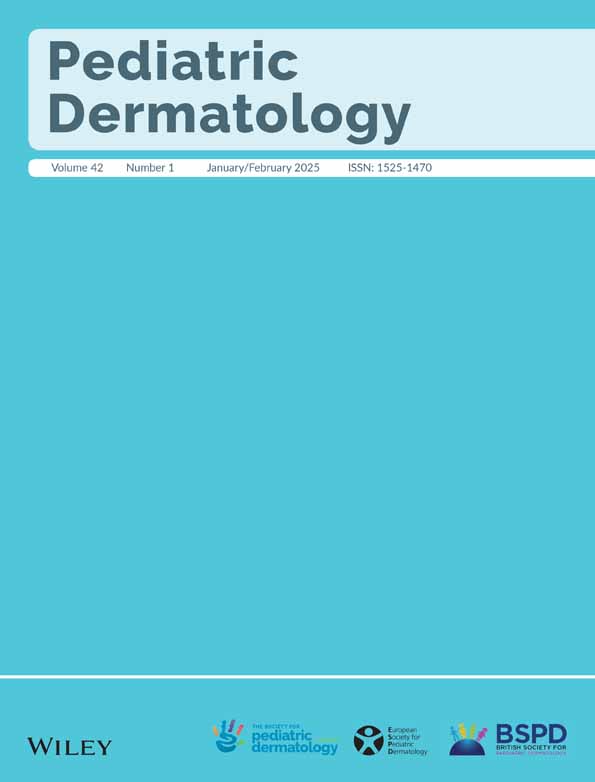Widespread dyspigmentation in a child
Corresponding Author
Megan Yap MBBS
Department of Dermatology, Perth Children's Hospital, Nedlands, Western Australia, Australia
Correspondence
Megan Yap, Department of Dermatology, Perth Children's Hospital, 15 Hospital Ave, Nedlands, WA 6009, Australia.
Email: [email protected]
Search for more papers by this authorBernadette Ricciardo MBBS
Department of Dermatology, Perth Children's Hospital, Nedlands, Western Australia, Australia
University of Western Australia, Crawley, Western Australia, Australia
Wesfarmers Centre of Vaccines and Infectious Diseases, Telethon Kids Institute, Nedlands, Western Australia, Australia
Department of Dermatology, Fiona Stanley Hospital, Murdoch, Western Australia, Australia
Search for more papers by this authorPrasad Kumarasinghe MD
University of Western Australia, Crawley, Western Australia, Australia
Search for more papers by this authorJean Iacobelli MBBS
University of Western Australia, Crawley, Western Australia, Australia
Pathwest QEII, Nedlands, Western Australia, Australia
Search for more papers by this authorJacqueline Chen MBBS
Department of Dermatology, Perth Children's Hospital, Nedlands, Western Australia, Australia
Search for more papers by this authorCorresponding Author
Megan Yap MBBS
Department of Dermatology, Perth Children's Hospital, Nedlands, Western Australia, Australia
Correspondence
Megan Yap, Department of Dermatology, Perth Children's Hospital, 15 Hospital Ave, Nedlands, WA 6009, Australia.
Email: [email protected]
Search for more papers by this authorBernadette Ricciardo MBBS
Department of Dermatology, Perth Children's Hospital, Nedlands, Western Australia, Australia
University of Western Australia, Crawley, Western Australia, Australia
Wesfarmers Centre of Vaccines and Infectious Diseases, Telethon Kids Institute, Nedlands, Western Australia, Australia
Department of Dermatology, Fiona Stanley Hospital, Murdoch, Western Australia, Australia
Search for more papers by this authorPrasad Kumarasinghe MD
University of Western Australia, Crawley, Western Australia, Australia
Search for more papers by this authorJean Iacobelli MBBS
University of Western Australia, Crawley, Western Australia, Australia
Pathwest QEII, Nedlands, Western Australia, Australia
Search for more papers by this authorJacqueline Chen MBBS
Department of Dermatology, Perth Children's Hospital, Nedlands, Western Australia, Australia
Search for more papers by this authorCONFLICT OF INTEREST STATEMENT
The authors declare no conflicts of interest.
REFERENCES
- 1Guitart J, Magro C. Cutaneous T-cell lymphoid dyscrasia: a unifying term for idiopathic chronic dermatoses with persistent T-cell clones. Arch Dermatol. 2007; 143(7): 921-932.
- 2Magro C, Hagen JW, Crowson AN, et al. Hypopigmented interface T-cell dyscrasia: a form of cutaneous T-cell dyscrasia distinct from hypopigmented mycosis fungoides. J Dermatol. 2014; 41(7): 609-617.
- 3Youssef R, Mahgoub D, Zeid OA, et al. Hypopigmented interface T-cell dyscrasia and hypopigmented mycosis fungoides: a comparative study. Am J Dermatopathol. 2018; 40(10): 727-735.
- 4Heng YK, Koh MJ, Giam YC, Tang MB, Chong WS, Tan SH. Pediatric mycosis fungoides in Singapore: a series of 46 children. Pediatr Dermatol. 2014; 31(4): 477-482.
- 5Kothari R, Szepietowski JC, Bagot M, et al. Mycosis fungoides in pediatric population: comprehensive review on epidemiology, clinical presentation, and management. Int J Dermatol. 2022; 61(12): 1458-1466.
- 6Rodney IJ, Kindred C, Angra K, Qutub ON, Villanueva AR, Halder RM. Hypopigmented mycosis fungoides: a retrospective clinicohistopathologic study. J Eur Acad Dermatol Venereol. 2017; 31(5): 808-814.




